Key Points:
- Snakes with hemotoxic venom include copperheads, boomslang, and rattlesnakes.
- According to the World Health Organization, there are between 81,410 and 137,880 deaths each year from venomous snake bites.
- The boomslang is a hemotoxic snake that can open its mouth 170 degrees to use its back fangs to deliver a nasty bite.
There are two primary kinds of snake venom, neurotoxic and hemotoxic. Some snakes have a venom cocktail including both, and some snakes have cytotoxic venom that affects cells. Hemotoxic refers to the venom that destroys red blood cells specifically, which affects tissues and internal organs. It can lead to heart attacks, limb loss, and internal bleeding. On the other hand, neurotoxic venom affects the nervous system and can cause muscle paralysis and unconsciousness. Both types of venom can be deadly.

Rattlesnakes are one kind of snake that has hemotoxic venom. It destroys red blood cells and can cause internal bleeding and organ failure.
©Maria Dryfhout/Shutterstock.com
How Deadly Are Venomous Snakes?
While deaths from snakebites are very low in the United States, worldwide it is an enormous health issue. According to the World Health Organization, there are between 81,410 and 137,880 deaths each year from venomous snake bites. Knowing what kind of snakes are hemotoxic and neurotoxic can help medical officials work quickly to administer the right antivenom when available.
What Kind of Snakes Are Hemotoxic vs Neurotoxic?
- Hemotoxic: Vipers (copperheads, boomslangs, rattlesnakes)
- Neurotoxic: Elapids (cobras, mambas, kraits, sea snakes, coral snakes)
What Are 11 Snakes With Hemotoxic Venom?
1. Eastern Diamondback Rattlesnake
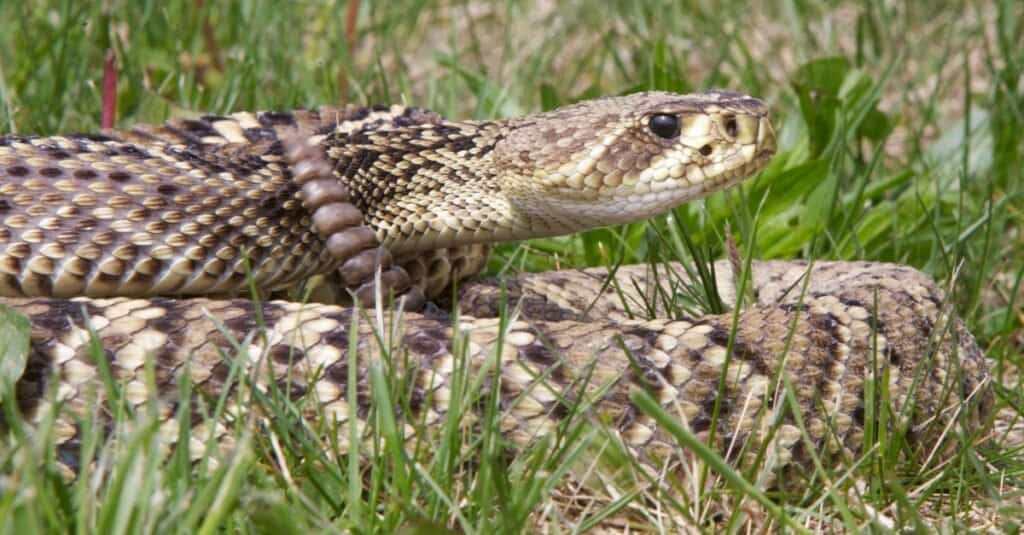
The Eastern diamondback
rattlesnake
is the largest venomous snake in the U.S.
©iStock.com/NajaShots
The Eastern diamondback rattlesnake is the largest venomous snake in the U.S. The largest ones can get to be 8 feet long and weigh close to 10 pounds. Eastern diamondbacks do live in the U.S. and they are responsible for the most deaths in the country. There are only an average of 5 snakebite-related deaths in the U.S. each year. The Western diamondback is another hemotoxic snake that is also responsible for deaths in the U.S.
2. Timber Rattlesnake
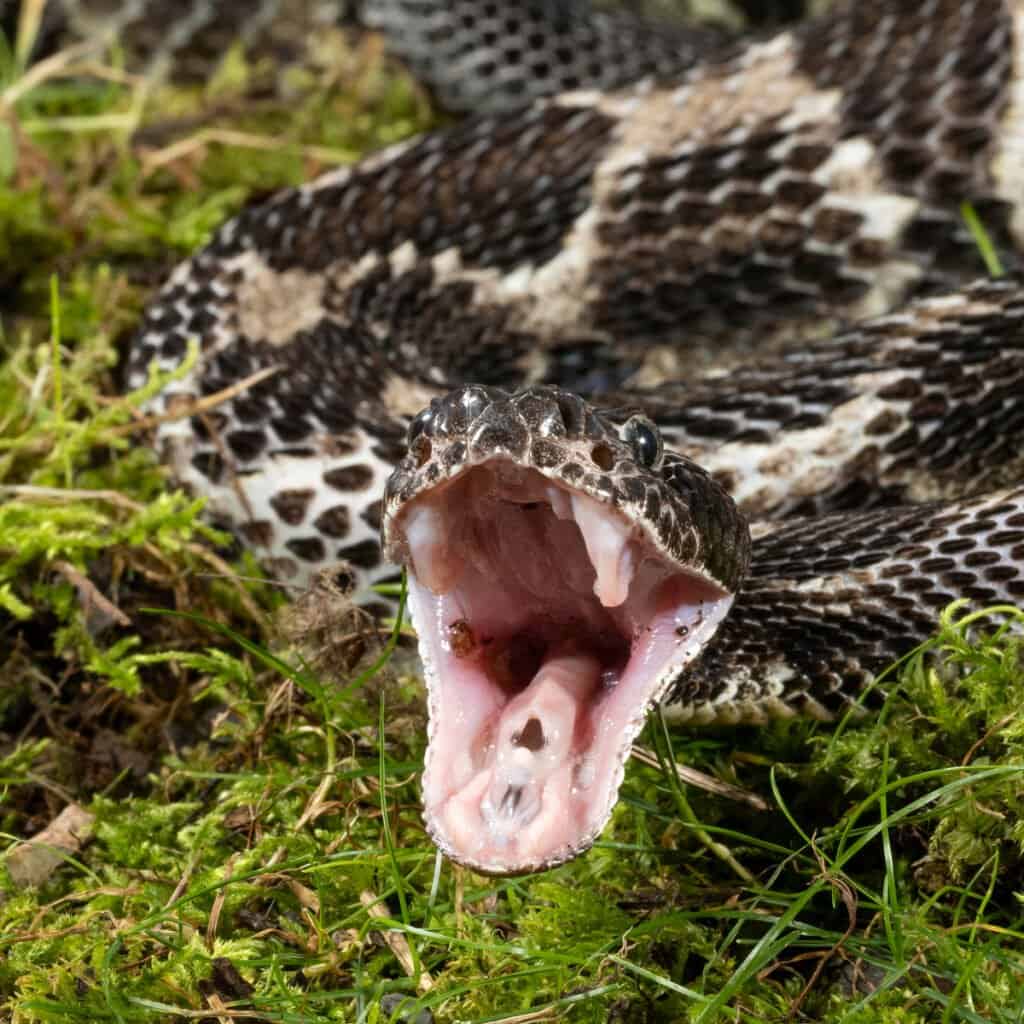
One of the most common venomous snakes in the U.S. is the timber rattlesnake.
©Joe McDonald/Shutterstock.com
The timber rattlesnake is the most common venomous snake in the U.S. Timber rattlers (also called canebrakes) are 3-7 feet long and thick-bodied snakes. As a rattlesnake, they have a rattle at the end of their tail that they will rattle to warn a predator. They can raise their bodies up and strike quickly with their venomous fangs, injecting their victim with hemotoxic venom that takes effect immediately. Medical attention should be sought as soon as possible if you are bitten by any venomous snake.
While most timber rattlesnakes have hemotoxic venom, scientific research shows that there are four possible types of venom: Hemotoxic, neurotoxic, a combination of those two, plus another, milder venom type.
3. Massasauga
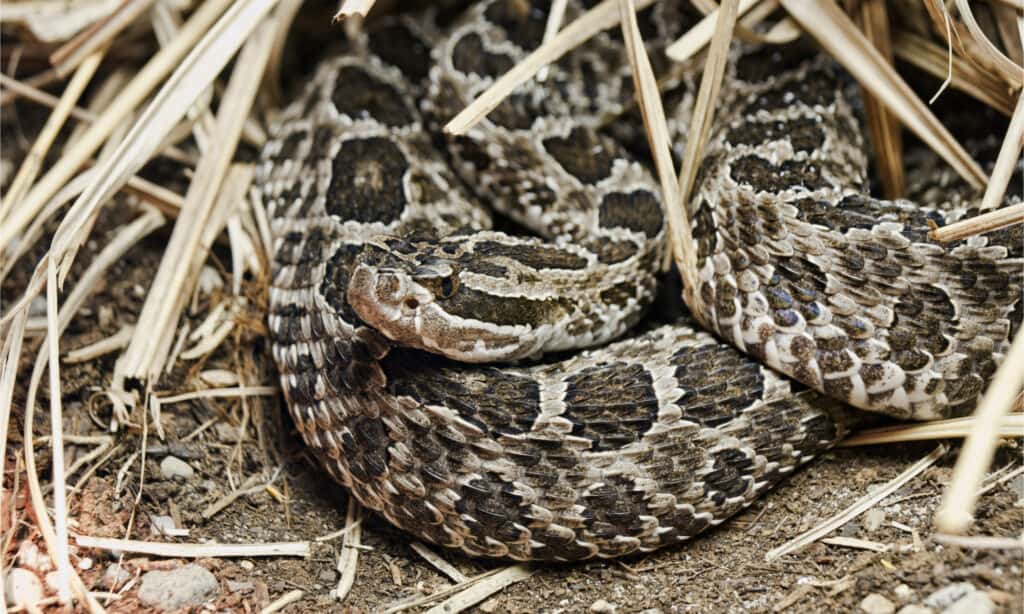
One of the smaller rattlesnakes is the Massasauga which can be found in the U.S., Canada, and Mexico.
©DnDavis/Shutterstock.com
Massasauga is another type of rattlesnake that can be found in the United States, southern Canada, and Mexico. They are smaller than timber and diamondback rattlesnakes and less aggressive. They prefer to remain hidden if approached by a predator and to rely on their camouflage. If they are provoked though, they will strike quickly and have a venomous bite.
4. Boomslang

Male boomslangs have a brown tint to their green bodies with black or blue outlines.
©iStock.com/FroeMic
Boomslang is an arboreal snake found in sub-Saharan Africa. The males are green with sometimes black outlined scales helping them blend in with the trees. They grow to about 3-5 feet in length but are skinnier snakes, especially when compared to a boa. The females typically have a brownish or olive color which also helps them stay camouflaged in their arboreal habitat. Boomslang is not overly aggressive but if they are threatened they will strike. They have the ability to open their mouths 170° so they can inject a fair amount of venom!
5. Copperhead

The snake that is recorded to deliver the most snake bites in the U.S. is the copperhead.
©iStock.com/David Kenny
Copperheads are pit vipers that have a rusty-copper-colored head, thus their name. They are smaller snakes at 2-3 feet and medium-thick. Although they deliver the most venomous bites of any snake in the U.S. they are not the deadliest because their venom is just not that strong. They live in a band across the southeastern U.S. but not as far south as Florida.
6. Sidewinder

If the sand seems to be moving on its own, look twice, there might be a camouflaged sidewinder in the sand. Look for the horns on their heads.
©Roger de Montfort/Shutterstock.com
These unique-looking snakes are sometimes called “horned rattlesnakes” due to the two horns on the top of their head. They are called sidewinders because they move sideways through the sand in an “S” shape. These desert snakes can be found in the southwestern U.S. in states like California, Nevada, Arizona, Utah, and Colorado. They are smaller snakes with an average length of 1 ½ – 2 ½ feet. As a rattlesnake, they are one of the snakes with hemotoxic venom.
7. Bushmaster

Bushmaster snakes strike multiple times and inject venom with each bite.
©Patrick K. Campbell/Shutterstock.com
The Bushmaster is not native to the United States. It lives in Central and South America in tropical rainforests. The biggest problem with Bushmasters is they strike multiple times and inject a lot of venom with each bite. Their fangs are some of the longest of all venomous snakes with some being not quite as long as the gaboon vipers of 2 inches. They are also large snakes that can get to be nearly 8 feet long.
8. Fer-de-lance
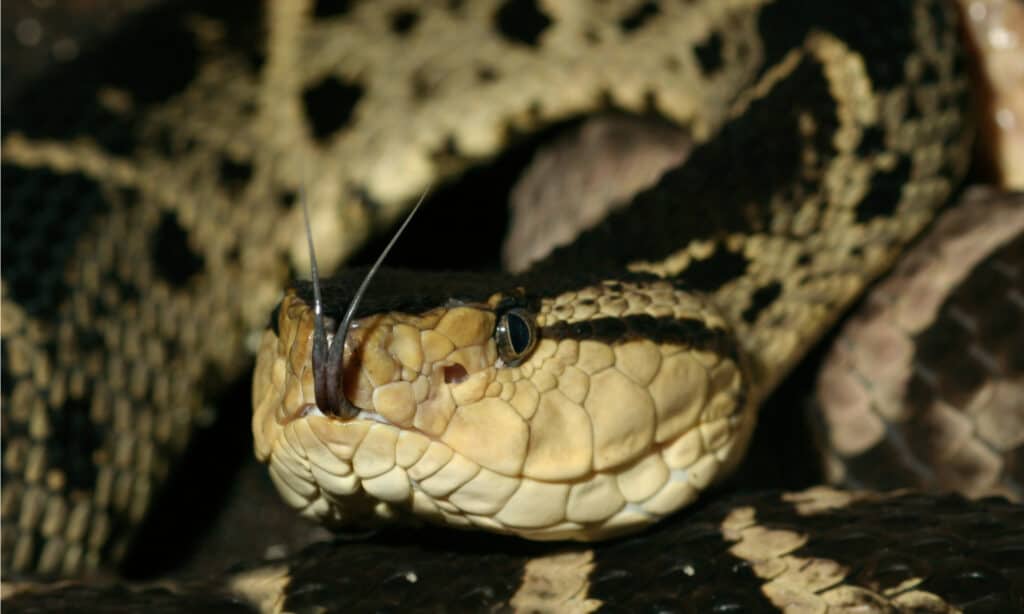
Watch out for the fer-de-lance snake. They can be found in Mexico, Central and South America.
©Mark_Kostich/Shutterstock.com
The fer-de-lance has venom that is very similar to the bushmaster. They also have a pretty impressive set of fangs. Fer-de-lance means “spearhead” in French, which describes the snake’s head that comes to a point at the nose. They live in Mexico, Central America, and South America. The problem with fer-de-lance is they have a reputation for being an aggressive snake, but snakes are almost never aggressive. Instead, they are highly defensive, some are extremely nervous. It is more dangerous than the Eastern diamondback, making it the deadliest snake in the Americas.
9. Puff Adder
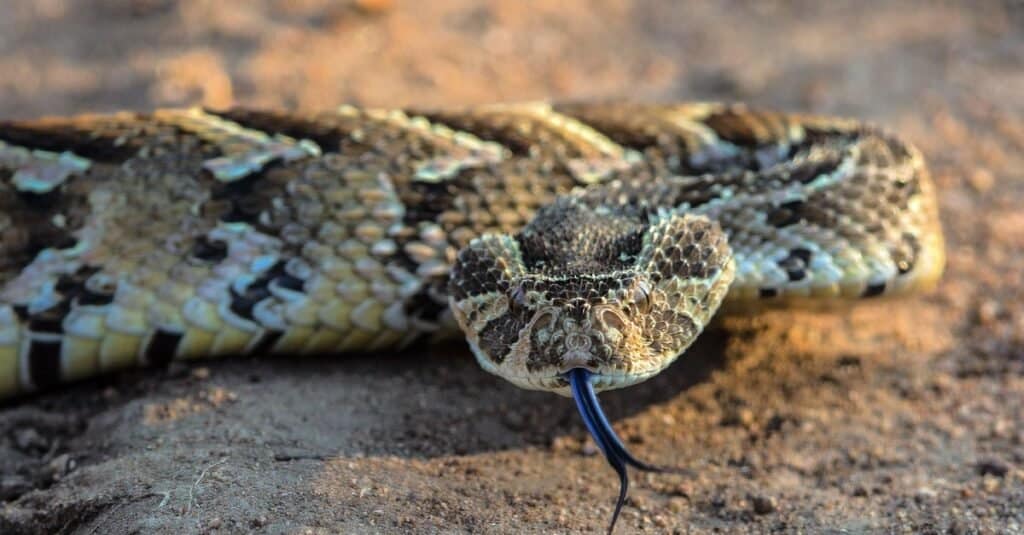
One of the most dangerous snakes in Africa is the puff adder They can puff their heads up to make themselves look bigger.
©iStock.com/S_Lew
Puff adders are one of the most dangerous snakes in Africa. They can puff up their bodies and especially their heads to make themselves look bigger. For a snake that is already 3-5 feet, it can look quite intimidating. They are tan with dark brown markings and cat-like eyes with vertical slits. One of the issues with Puff adders is they like to hang out next to common walking paths used by barefoot villagers. This is a recipe for snake bites.
10. Russel’s Viper
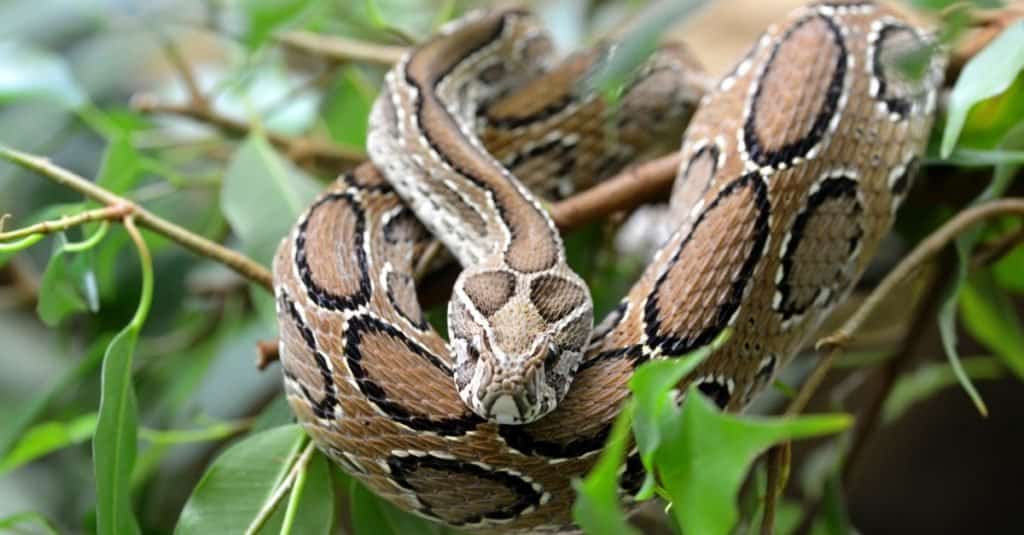
Look at the unique pattern on Russel’s viper. Now be sure to stay away from any snake that looks like that. They have enough venom to kill 22 humans!
©jaroslava V/Shutterstock.com
One of the problematic snakes that have hemotoxic venom in India is Russel’s viper. It is said to have “enough venom to kill 22 humans”! One statistic puts 40 mg of venom as the lethal limit for humans, but Russel’s viper is capable of injecting 275 mg! Another disturbing characteristic is they will sometimes bite and hold on vs. delivering a quick bite and getting away. Definitely a dangerous snake.
11. Saw-Scaled Viper
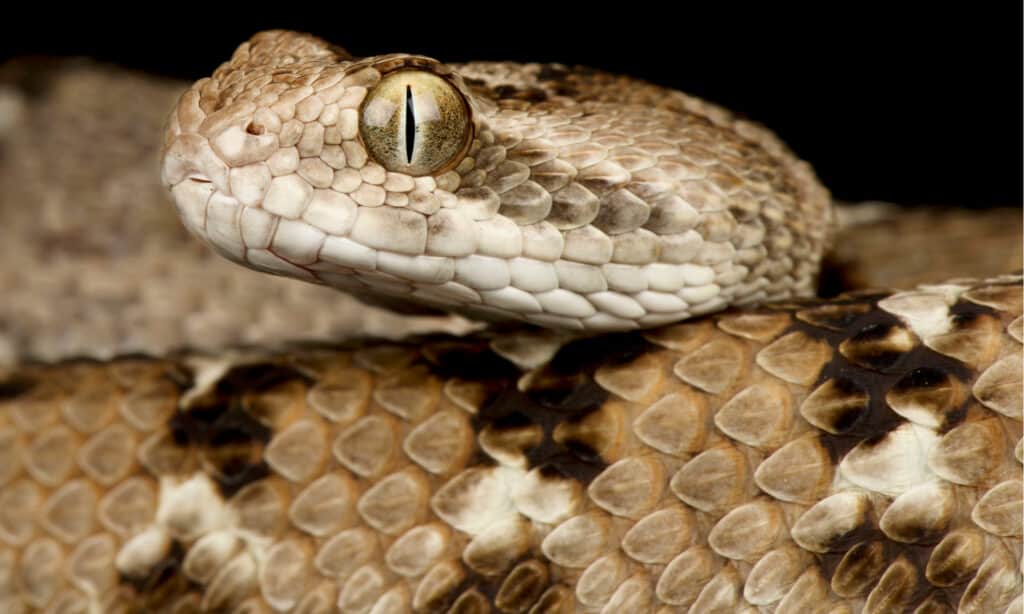
One of the deadliest snakes in the world is the saw-scaled viper. They live in India where there are limits to access to medical facilities and antivenom.
©reptiles4all/Shutterstock.com
The saw-scaled viper is considered one of the deadliest snakes in the world. It is responsible for the most deaths in the world. Considering that it’s a common snake in India, where there can be limited access to medical facilities and a large population of people living in rural areas, the numbers add up. The saw-scaled viper is also an aggressive snake that strikes fast and multiple times. Despite the frequency of bites, it is only fatal in about 10% of the cases. By far one of the most dangerous snakes that have hemotoxic venom!
Summary Of 11 Snakes With Hemotoxic Venom
| Rank | Snake |
|---|---|
| 1 | Eastern Diamondback Rattlesnake |
| 2 | Timber Rattlesnake |
| 3 | Massasauga |
| 4 | Boomslang |
| 5 | Copperhead |
| 6 | Sidewinder |
| 7 | Bushmaster |
| 8 | Fer-de-lance |
| 9 | Puff Adder |
| 10 | Russel’s Viper |
| 11 | Saw-Scaled Viper |
The photo featured at the top of this post is © reptiles4all/Shutterstock.com
Discover the "Monster" Snake 5X Bigger than an Anaconda
Every day A-Z Animals sends out some of the most incredible facts in the world from our free newsletter. Want to discover the 10 most beautiful snakes in the world, a "snake island" where you're never more than 3 feet from danger, or a "monster" snake 5X larger than an anaconda? Then sign up right now and you'll start receiving our daily newsletter absolutely free.
Thank you for reading! Have some feedback for us? Contact the AZ Animals editorial team.






